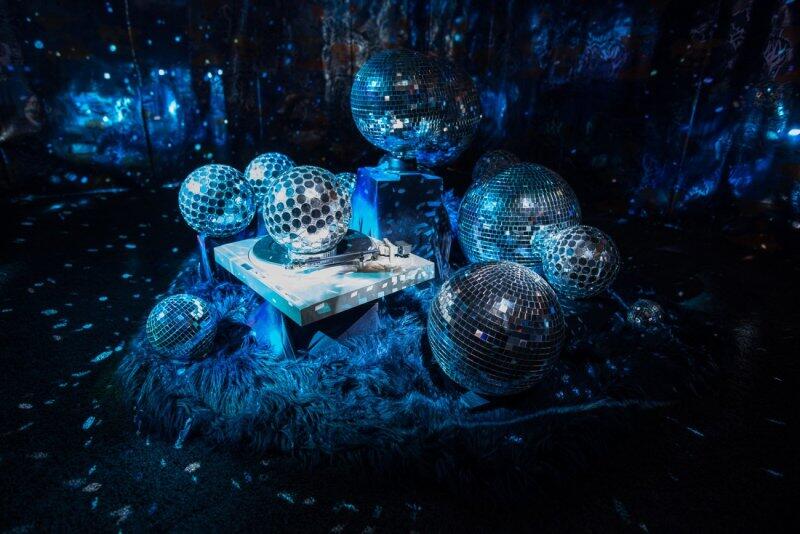Cauleen Smith Makes a Case for ‘Radical Generosity’
At the Los Angeles County Museum of Art, 'Give It or Leave It' sees the Watts Towers and Alice Coltrane's Sai Anantam Ashram as visionary sites for worldbuilding
At the Los Angeles County Museum of Art, 'Give It or Leave It' sees the Watts Towers and Alice Coltrane's Sai Anantam Ashram as visionary sites for worldbuilding

'Give It or Leave It’, Cauleen Smith’s immersive, kaleidoscopic solo exhibition at Los Angeles County Museum of Art, begins with the proposition to give instead of take. A revision of the saying ‘take it or leave it’, the title signals what Smith describes in the exhibition catalogue as an act of ‘radical generosity’ and the show – which encompasses film, video, installation and sculpture – certainly exudes generosity in its visual exuberance and celebration of utopian worldbuilding. Yet, the travelling exhibition – organized by the Institute of Contemporary Art, University of Pennsylvania – also recognizes that the habit of taking is not easily overcome.
Low lighting mingled with multicoloured windows creates an intimate atmosphere as well as a sense of continuity among the people and sites that recur throughout the show. Key among them are famed jazz musician and spiritual leader Alice Coltrane, spiritualist Rebecca Cox Jackson, who established Philadelphia’s Black Shaker community in 1859, and the 1970s Boston-based, Black feminist group Combahee River Collective.

Smith evokes the spirit of these visionaries through immateriality: an interplay of light, shadow and reflection. Space Station: Two Rebeccas (2018), composed of several small disco balls, imagines Jackson and her lifelong companion and protégé, Rebecca Perot, as a dazzling cosmic light that shines onto the silvery wallpaper of the room. Nearby, Coltrane and Jackson are the main subjects of the short film Pilgrim (2017), where Coltrane’s piano composition ‘One for the Father’ (1978) accompanies a bucolic, dreamlike montage that begins at her Sai Anantam Ashram in California’s Agoura Hills and travels to the Watts Towers in Los Angeles, artist Noah Purifoy’s Outdoor Desert Museum in Joshua Tree and the Watervliet Shaker Village in Colonie, New York.
The film’s nonlinear structure reflects the intuitive connections that Smith maps throughout the exhibition. Custom-made wallpaper covers much of the main gallery with motifs of the show’s many locations. An unpublished photograph of Black men relaxing in front of the towers – taken by Bill Ray for a 1966 Life magazine feature on the aftermath of the 1965 Watts Rebellion – hangs on one wall.

Ray’s photo serves as inspiration for Sojourner (2018), a 22-minute film that embarks on a westward journey from the Coltrane and Sun Ra residences in Philadelphia to a protest in Chicago by R3, a coalition of democratic organizations devoted to fighting racial and economic oppression. The film concludes at Purifoy’s museum, which was constructed from the detritus he collected after the Watts Rebellion. Amid Purifoy’s sculptures, a procession of glamorous Black, Asian and Latinx women hold translucent banners bearing lines from Coltrane’s autobiography, Monument Eternal (1977): ‘At dawn, sit at the feet of action. At noon, be at the hand of might. At eventide, be so big that sky will learn sky.’ In the final scene, the women re-create Ray’s photo within the museum’s otherworldly landscape, replacing male camaraderie with formidable womanhood.
The show ends with Epistrophy (2018), an installation featuring an array of objects – from bronze figurines to taxidermy crows – placed in front of monitors screening space- or landscapes sourced from NASA and National Geographic. CCTV cameras project images of the objects and their backgrounds onto nearby walls, allowing them to inhabit their own fantastical worlds while also positioning them as subjects of surveillance. This utopian-dystopian scenario parallels that of the transcendent spirit and the embodied subject: the gift of giving and the violence of taking. ‘Give It or Leave It’ posits the potential of giving not just to oppose but to subvert. Though the show revels in colour, light and sound, Smith underscores that the promise of utopia is inevitably intertwined with the politics of representation and that ‘radical generosity’ is, indeed, a political act.
'Give It or Leave It' is on view at the Los Angeles County Museum of Art through 31 October 2021.
Main image: Cauleen Smith, Sojourner, 2018, production still, single-channel video: color and sound, 22:41 minutes. Courtesy: the artist, Corbett vs. Dempsey, Chicago, and Kate Werble Gallery, New York, and Institute of Contemporary Art, University of Pennsylvania























